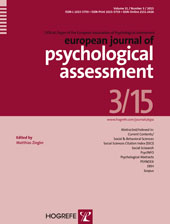Hungarian Validation of the Penn State Worry Questionnaire (PSWQ)
Method Effects and Comparison of Paper-Pencil Versus Online Administration
Abstract
Abstract. The Hungarian version of the Penn State Worry Questionnaire (PSWQ) was validated in two studies, using five different samples. Study 1 tested the factor structure and internal consistency of the PSWQ in two undergraduate student samples, comparing the psychometric properties of the paper-pencil and the online versions of the scale. Study 2 assessed construct validity in two undergraduate student samples and in a sample of patients diagnosed with Generalized Anxiety Disorder (GAD) and matched control participants. Our results suggest that the Hungarian PSWQ demonstrates good psychometric properties. We found no difference between the online and the paper-pencil versions of the scale. A factor structure with one general worry factor and two method factors representing wording effects showed the best fit to the data.
References
. (2001). Diagnostic and statistical manual of mental disorders – text revision (4th ed.). Washington, DC: APA
(1961). An inventory for measuring depression. Archives of General Psychiatry, 4, 561–571.
(1995). Psychometric properties of the Penn State Worry Questionnaire in older adults. Journal of Clinical Geropsychology, 1, 33–42.
(2003). Confirmatory factor analysis of the Penn State Worry Questionnaire: Multiple factors or method effects? Behaviour Research and Therapy, 41, 1411–1426.
(1983). Preliminary exploration of worry: Some characteristics and processes. Behaviour Research and Therapy, 21, 9–16.
(2003). Internet-based questionnaire assessment: Appropriate use in clinical contexts. Cognitive Behaviour Therapy, 32, 100–109.
(2002). Evaluating goodness-of-fit indexes for testing measurement invariance. Structural Equation Modeling: A Multidisciplinary Journal, 9, 233–255.
(1991). Tripartite model of anxiety and depression: Psychometric evidence and taxonomic implications. Journal of Abnormal Psychology, 100, 316–336.
(2002). Factorial structure of a French version of the Penn State Worry Questionnaire. European Journal of Psychological Assessment, 18, 158–164. doi: 10.1027/1015-5759.18.2.158
(2004). Factor structure of the Penn State Worry Questionnaire: Examination of a method factor. Assessment, 11, 361–370.
(2009). A temperamentum alapdimenziójának egyik mérőeszközével, a büntetés- és jutalomérzékenység kérdőívvel (SPSRQ) szerzett hazai tapasztalatok
[A temperament dependent dimension: Psychometric properties of the Sensitivity to Punishment and Sensitivity to Reward Questionnaire (SPSRQ) on Hungarian sample] . Mentálhigiéné és Pszichoszomatika, 10, 153–172.(2008). The Penn State Worry Questionnaire: Psychometric properties of the Korean version. Depression and Anxiety, 25, E97–E103.
(1990). Development and validation of the Penn State Worry Questionnaire. Behaviour Research and Therapy, 28, 487–495.
(1998–2010). Mplus user’s guide (6th ed.). Los Angeles, CA: Muthén & Muthén.
(2006). A Norwegian adaptation of the Penn State Worry Questionnaire: Factor structure, reliability, validity and norms. Scandinavian Journal of Psychology, 47, 281–291.
(2006).
Worry in psychopathology . In G. C. L. DaveyA. WellsEds., Worry and its psychological disorders: Theory, assessment and treatment (pp. 41–51). West Sussex, UK: Wiley & Sons.(2010). Bifactor models and rotations: Exploring the extent to which multidimensional data yield univocal scale scores. Journal of Personality Assessment, 92, 544–559.
(2012). When can categorical variables be treated as continuous? A comparison of robust continuous and categorical SEM estimation methods under suboptimal conditions. Psychological Methods, 17, 354–373.
(2001). A Beck Depresszió Kérdőív rövidített változatának jellemzői a hazai mintán.
[Psychometric properties of the shortened version of the Beck Depression Inventory on a national sample] . Psychiatria Hungarica, 16, 379–397.(1998).
A State-Trait Anxiety Inventory (STAI) magyar változata [The Hungarian version of the State-Trait Inventory (STAI)] . In F. MéreiF. SzakácsEds., Pszichodiagnosztikai vademecum,[Handbook for Psychodiagnostics] (Vol. 1, pp. 123–135). Budapest, Hungary: Nemzeti Tankönyvkiadó.(1970). Manual for the State-Trait Anxiety Inventory, Palo Alto, CA: Consulting Psychologists’ Press.
(2006).
The Penn State Worry Questionnaire . In G. C. L. DaveyA. WellsEds., Worry and its psychological disorders. Research, theory and treatment (pp. 101–121). West Sussex, UK: Wiley.(2013). Analyzing observed composite differences across groups. Methodology: European Journal of Research Methods for the Behavioral and Social Sciences, 9, 1–12.
(1995). Besorgnis: Ein Vergleich dreier Inventare zur Erfassung allgemeiner Sorgen
[Worrying: A comparison of three questionnaires concerning everyday worries] . Zeitschrift für Differentielle und Diagnostische Psychologie, 16, 50–63.(2001). The sensitivity to punishment and sensitivity to Reward Questionnaire (SPSRQ) as a measure of Gray’s anxiety and impulsivity dimensions. Personality and Individual Differences, 31, 837–862.
(2010). Factor structure of the Dutch version of the Penn State Worry Questionnaire. Journal of Behavior Therapy and Experimental Psychiatry, 41, 304–309.
(1999). The Penn State Worry Questionnaire and the Worry Domains Questionnaire: Structure, reliability and validity. Clinical Psychology and Psychotherapy, 6, 297–307.
(2012). The online version of the Dutch Penn State Worry Questionnaire: Factor structure, predictive validity and reliability. Journal of Anxiety Disorders, 26, 844–848.
(2008). Constructive and unconstructive repetitive thought. Psychological Bulletin, 134, 163–206.
(2002). Evaluation of cut-off criteria of model fit indices for latent variable models with categorical and continuous outcomes, (Doctoral dissertation, University of California, Los Angeles). Retrieved from http://www.statmodel.com/download/Yudissertation.pdf
(2009). Psychometric properties of internet administered versions of Penn State Worry Questionnaire (PSWQ) and Depression, Anxiety, and Stress Scale (DASS). Computers in Human Behavior, 25, 841–843.



